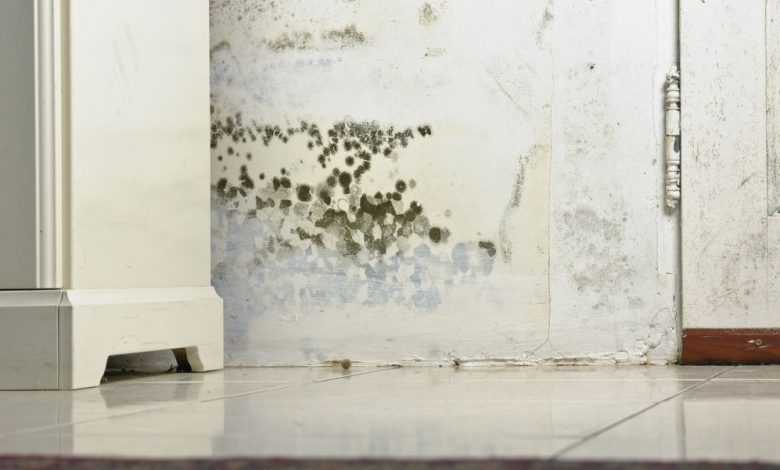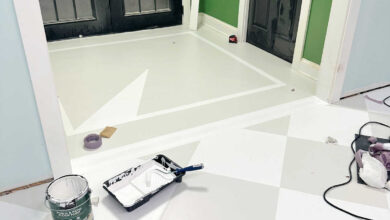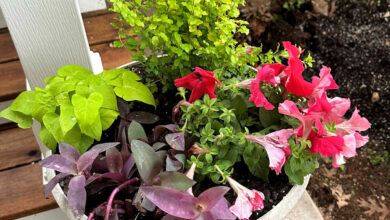How to Get Rid of Black Mold

So-called black mold is a double whammy for homeowners. Not only is the toxigenic fungi potentially harmful to your health, it’s a sure sign of a serious moisture issue in your home. Fortunately, like any mold, it can be eliminated with the right combination of supplies, know-how and good old-fashioned elbow grease.
What exactly is “black mold”?
The truth is, there’s no single species of black mold out there. Lots of different molds are black in color, but you could never tell what’s what in your home unless you had it tested by a lab (and it almost never makes sense to do that).
When people talk about “black mold,” they’re usually referring to Stachybotrys chartarum, a greenish-black mold that can grow on damp building materials, including drywall and fiberboard, explains Kevin Kennedy, Director of the Environmental Health Program at Children’s Mercy Hospital in Kansas City, MO.
What are the health risks of black mold?
Naturally occurring molds are all around us, both indoors and out. But it’s when mold lands on something wet, say a damp bathroom wall, and starts to colonize that it becomes a problem. That’s when mold spores produce allergens and irritants that can trigger asthma attacks and allergic symptoms, including sneezing, skin rashes and runny noses, according to the U.S. Environmental Protection Agency. In the case of Stachybotrys chartarum, the spores can also produce poisonous chemicals called mycotoxins. But the same is true for many molds, given the right conditions. That’s why the Center for Disease Control and Prevention says: “It is not necessary to determine what type of mold you may have growing in your home. All molds should be treated the same with respect to potential health risks and removal.”
How to get rid of mold fast
First, you’ll want to determine the size of the outbreak. This will tell you if you can clean the mold yourself, or if it’s reached a point where you need to bring in the pros. If the outbreak is less than 10 square feet, the EPA says it’s safe to handle the cleanup yourself (FEMA sets the limit at 25 square feet, so there’s some wiggle room). Professional mold remediation is expensive, costing around $2,000 on average. That’s another reason why it pays to jump on mold outbreaks before they have a chance to spread.
Assuming the mold cleanup situation is still DIY, start by gathering your tools and materials, then follow these step-by-step instructions for mold removal.
Tools
- Face mask
- Eye protection
- Rubber gloves
- Vacuum
- Bucket
- Spray bottle
- Sponge
- Scrub brush
- Cloths/rags
Materials
- Dish soap
- Specialized mold and mildew cleaner
- Chlorine bleach (if necessary)
Instructions
Step 1: Protect yourself with the proper gear
To avoid breathing in mold spores, wear an N-95 mask. Put on gloves and goggles (without ventilation holes) to protect your hands and eyes from mold, as well as cleaning agents.
Step 2: Remove any wet items
This is especially important after a flood, when things like furniture, rugs, bedding and toys might be soaked. Provided you get to them within 48 hours, there’s a chance they can be dried out, cleaned and reused. Monitor the items for several days, and discard at the first sign of mold.
Step 3: Clean contaminated surfaces
The mold-cleaning process varies by surface. Our experts recommend starting with a gentle cleaner, and only moving onto bleach if the mold persists. Never mix bleach with ammonia or other household cleaners since it will produce a poisonous gas.
- Walls and ceilings: If the surface is very porous, like an acoustic ceiling tile, it’s best to replace it. For smooth drywall or plaster, mix a solution of a few drops of dish soap, like Dawn Platinum, with a gallon of water. Apply the solution to the mold with a sponge, then rinse with clean water. If mold remains, mix a solution of ¾ cup of chlorine bleach to a gallon of warm water, apply it with a sponge or brush, and rinse.
- Bathroom tile and grout: Tackle small areas of mold with a specialized cleaner, like Clorox Tilex Mold and Mildew Remover. Spray the grout, let the formula penetrate, and rinse. If the mold persists, try a bleach-and-water solution; an old toothbrush is handy for applying the solution and scrubbing the grout.
- Shower curtains and liners: If made of plastic, spray moldy areas with a specialized cleaner. Wait for the stains disappear, then rinse with clean water. You can also wash plastic liners in the washing machine on the delicate cycle with warm water, laundry detergent and bleach. If the shower curtain is fabric, wash it on the warmest possible setting, according to the care instructions on the label.
- Wood surfaces: Mold can grow on wood cabinets, paneling or furniture, especially in humid environments. Use a vacuum with a HEPA filter to suck up loose spores with the soft brush attachment. Apply a detergent solution to the mold with a sponge. Follow with a cloth dipped in clear water, then wipe the surface dry. If mold remains, move on to the bleach solution.
Step 5: Check back for mold regrowth
Unfortunately, there’s no clear guideline for how long you need to wait to know if your mold problem is fixed. Monitor the area over the next few days for the return of visible mold or musty odors.
If you cleaned thoroughly and took care of the underlying moisture problem (more on that below), you should be in the clear. If not, it may be that the mold is hidden, for example behind wallpaper or on the top side of ceiling tiles. Experts strongly advise bringing in a professional remediation service to investigate the situation in that case. “In those rare cases where a homeowner’s health is seriously impacted by mold, it’s usually because they started ripping open walls and caused a massive release of spores,” says Kennedy. “It doesn’t happen a lot, but it does happen.”
How to keep mold from returning
No matter how diligent you are about removing visible mold, if you don’t address the underlying issue, it will come back. “Where there’s mold, there’s moisture,” says Larry Zarker, CEO of the Building Performance Institute, which trains and certifies professionals who specialize in creating healthy, safe and efficient homes. Here are some common mold hangouts in homes, along with ways to eliminate their moisture source.
- Basements: Make sure gutters are channeling water away from the house. Plug cracks in foundation walls with an epoxy injection system or bring in a pro for the repair. Install a sump pump to clear water in the event of flooding or heavy rain. Put in a dehumidifier to remove moisture in the air.
- Bathrooms: Keep the room ventilated by cracking a window, especially after showering. If you have an exhaust fan, run it while showering then leave it on for at least twenty minutes after; also leave the door ajar. Periodically check for leaks under the sink, as well as a spongy floor, which could be a sign of leaky toilet, shower stall or bathtub. Clean shower grout lines regularly with a specialized grout cleaner designed for the task.
- Ceilings and Walls: Leaky roofs are the common culprit here. Check for missing shingles or failed flashing around openings in the roof, like at a chimney or dormer. Inspect siding for cracks or openings, including where vents and plumbing lines enter the house.
- Kitchens: Regularly crack a window for ventilation. If you have a range hood, run it while cooking and then for twenty minutes after to ventilate steam, along with smoke and cooking fumes. Check under the sink for leaks. Inspect the seal around your refrigerator; if there’s sign of mold, air is likely escaping, so you’ll need to replace the gasket.
- Windowsills: Seal any cracks around the window where rain is entering with caulk. If condensation is forming on the windows, and they’re double-pane, you might be able replace the glass panel to stop the moisture. But it might be necessary to replace the entire unit.
This content is created and maintained by a third party, and imported onto this page to help users provide their email addresses. You may be able to find more information about this and similar content at piano.io
Source link






